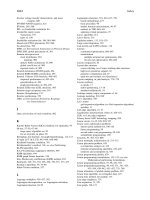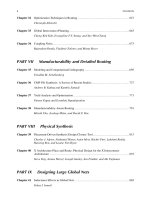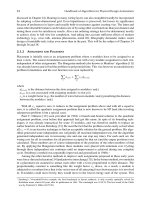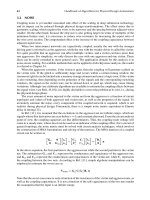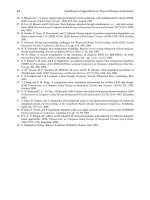Handbook of Materials for Product Design Part 14 pptx
Bạn đang xem bản rút gọn của tài liệu. Xem và tải ngay bản đầy đủ của tài liệu tại đây (1.41 MB, 80 trang )
Plastics Joining Materials and Processes 11.31
Common ultrasonic welding joint designs are shown in Fig. 11.10.
The most common design is a butt joint that uses an energy director.
This design is appropriate for most amorphous plastic materials. The
wedge design concentrates the vibrational energy at the tip of the en-
ergy director. A uniform melt then develops where the volume of mate-
rial formed by the energy director becomes the material that is
consumed in the joint. Without the energy director, a butt joint would
produce voids along the interface, resulting in stress and a low
strength joint. Shear and scarf joints are employed for crystalline
polymeric materials. They are usually formed by designing an inter-
ference fit.
Ultrasonic welding can also be used to stake plastics to other
substrates and for inserting metal parts. It can also be used for spot
welding two plastic components. Figure 11.11 illustrates ultrasonic in-
sertion, swaging, stacking, and spot welding operations. In ultrasonic
spot welding, the horn tip passes through the top sheet to be welded.
The molten plastic form a neat raised ring on the surface that is
shaped by the horn tip. Energy is also released at the interface of the
two sheets, producing frictional heat. As the tip penetrates the bottom
Figure 11.9 Ultrasonic weldability index for common thermoplastics.
17
11Petrie Page 31 Wednesday, May 23, 2001 10:41 AM
11.32 Chapter 11
substrate, displaced molten plastic flows between the sheets into the
preheated are and forms a permanent bond.
Ultrasonic heating is also applicable to hot-melt and thermosetting
adhesives.
20
In these cases, the frictional energy is generated by the
substrate contacting an adhesive film between the two substrates. The
frictional energy generated is sufficient either to melt the hot melt ad-
hesive or to cure the thermosetting adhesive.
11.6.3 Vibration Welding
Vibration welding is similar to ultrasonic welding in that it uses the
heat generated at the surface of two parts rubbing together. This fric-
tional heading produces melting in the interfacial area of the joint.
11Petrie Page 32 Wednesday, May 23, 2001 10:41 AM
Plastics Joining Materials and Processes 11.33
Figure 11.10 Ultrasonic welding joints for amorphous and crystalline polymeric mate-
rials.
18
11Petrie Page 33 Wednesday, May 23, 2001 10:41 AM
11.34 Chapter 11
Figure 11.11 Ultrasonic joining operations. (a) Swaging: the plastic ridge is melted
and reshaped (left) by ultrasonic vibration to lock another part into place. (b) Staking:
ultrasonic vibrations melt and reform a plastic stud (left) to lock a dissimilar compo-
nent into place (right). (c) Insertion: a metal insert (left) is embedded in a preformed
hold in a plastic part by ultrasonic vibration (right). (d) Spot welding: two plastic
components (left) are joined at localized points (right).
19
(a)
(c)
(d)
(b)
11Petrie Page 34 Wednesday, May 23, 2001 10:41 AM
Plastics Joining Materials and Processes 11.35
Vibration welding is different from ultrasonic welding, however, in
that it uses lower frequencies of vibration, 120–240 Hz rather than
20–40 kHz as used for ultrasonic welding. With lower frequencies,
much larger parts can be bonded because of less reliance on the power
supply. Figure 11.12 shows the joining and sealing of a two-part plas-
tic tank design of different sizes using vibration welding.
There are two types of vibration welding: linear and axial. Linear vi-
bration welding is most commonly used. Friction is generated by a lin-
ear, back-and-forth motion. Axial or orbital vibration welding allows
irregularly shaped plastic parts to be vibration welded. In axial weld-
ing, one component is clamped to a stationary structure, and the other
component is vibrated using an orbital motion.
Vibration welding fills a gap in the spectrum of thermoplastic weld-
ing in that it is suitable for large, irregularly shaped parts. Vibration
welding has been used successfully on large thermoplastic parts such
as canisters, pipe sections, and other parts that are too large to be ex-
cited with an ultrasonic generator and ultrasonically welded. Vibra-
tion welding is also capable of producing strong, pressure-tight joints
at rapid rates. The major advantage is its application to large parts
and to non-circular joints, provided that a small relative motion be-
tween the parts in the welding plane is possible.
Usually, the manufacturers of ultrasonic welding equipment will
also provide vibration welding equipment. Vibration welding equip-
ment can be either electrically driven (variable frequency) or hydrauli-
cally driven (constant frequency). Capital cost is generally higher than
with ultrasonic welding.
Process parameters to control in vibration welding are the ampli-
tude and frequency of motion, weld pressure, and weld time. Most in-
Figure 11.12 Linear and axial vibration welding of a two-part con-
tainer.
21
11Petrie Page 35 Wednesday, May 23, 2001 10:41 AM
11.36 Chapter 11
dustrial vibration welding machines operated at frequencies of 120 to
240 Hz. The amplitude of vibration is usually less than 0.2 in. Lower
weld amplitudes are used with higher frequencies. Lower amplitudes
are necessary when welding parts into recessed cavities. Lower ampli-
tudes (0.020 in) are used for high-temperature thermoplastics. Joint
pressure is held in the rage of 200 to 250 psi, although at times much
higher pressures are required. High mechanical strength can usually
be obtained at shorter weld times by decreasing the pressure during
the welding cycle. Vibration welding equipment has been designed to
vary the pressure during the welding cycle to improve weld quality
and decrease cycle times. This also allows more of the melted polymer
to remain in the bond area, producing a wider weld zone.
Vibration welding times depend on the melt temperature of the
resin and range from 1 to 10 s with solidification times of less than 1 s.
Total cycle times typically range form 6 to 15 s. This is slightly longer
than typical spin welding and ultrasonic welding cycles but much
shorter than hot plate welding and solvent cementing.
A number of factors must be considered when vibration welding
larger parts. Clearances must be maintained between the parts to al-
low for movement between the halves. The fixture must support the
entire joint area, and the parts must not flex during welding. Vibra-
tion welding is applicable to a variety of thermoplastic parts with pla-
nar or slightly curved surfaces. The basic joint is a butt joint but,
unless parts have thick walls, a heavy flange is generally required to
provide rigidity and an adequate welding surface. Typical joint de-
signs for vibration welds are shown in Fig. 11.13.
Vibration welding is ideally suited to injection molded or extruded
parts in engineering thermoplastics as well as acetal, nylon, polyethyl-
ene, ionomer, and acrylic resins. Almost any thermoplastic can be vi-
bration welded. Unlike other welding methods, vibration welding is
applicable to crystalline or amorphous or filled, reinforced, or pig-
mented materials. Vibration welding also can be utilized with fluo-
ropolymers and polyester elastomers, none of which can be joined by
ultrasonic welding. By optimizing welding parameters and glass fiber
loadings, nylon 6 and nylon 6,6 butt joints can be produced having up
to 17% higher strength than the base resin.
23
Any pair of dissimilar
materials that can be ultrasonically joined can also be vibration
welded.
Vibration welding techniques have found several applications in the
automobile industry, including emission control canisters, fuel pumps
and tanks, headlight and tail light assemblies, heater valves, air in-
take filters, water pump housings, and bumper assemblies. They have
also been used for joining pressure vessels and for batteries, motor
housings, and butane gas lighter tanks.
11Petrie Page 36 Wednesday, May 23, 2001 10:41 AM
Plastics Joining Materials and Processes 11.37
11.7 Solvent Cementing
Solvent cementing is the simplest and most economical method of join-
ing noncrystalline thermoplastics. In solvent cementing, the applica-
tion of the solvent softens and dissolves the substrate surfaces being
bonded. The solvent diffuses into the surface allowing increased free-
dom of movement of the polymer chains. As the parts are then brought
together under pressure, the solvent softened plastic flows. Van der
Walls attractive forces are formed between molecules from each part,
and polymer chains from each part intermingle and diffuse into one
another. The parts then are held in place until the solvent evaporates
from the joint area.
Solvent-cemented joints of like materials are less sensitive to ther-
mal cycling than joints bonded with adhesives, because there is no
Figure 11.13 Typical vibration welding joint designs.
21
11Petrie Page 37 Wednesday, May 23, 2001 10:41 AM
11.38 Chapter 11
stress at the interface due to differences in thermal expansion be-
tween the adhesive and the substrate. When two dissimilar plastics
are to be joined, adhesive bonding is generally desirable because of
solvent and polymer compatibility problems. Solvent cemented joints
are as resistant to degrading environments as the parent plastic. Bond
strength greater than 85% of the parent plastic can generally be ob-
tained. Solvents provide high strength bonds quickly due to rapid
evaporation rates.
Solvent bonding is suitable for all amorphous plastics. It is used pri-
marily on ABS, acrylics, cellulosics, polycarbonates, polystyrene,
polyphenylene oxide, and vinyls. Solvent welding is not suitable for
crystalline thermoplastics. It is not affective on polyolefins, fluorocar-
bons, or other solvent resistant polymers. Solvent welding is moder-
ately affective on nylon and acetal polymers. Solvent welding cannot
be used to bond thermosets. It can be used to bond soluble plastics to
unlike porous surfaces, including wood and paper, through impregna-
tion and encapsulation of the fibrous surface.
The major disadvantage of solvent cementing is the possibility of
stress cracking in certain plastic substrates. Stress cracking or craz-
ing is the formation of microcracks on the surface of a plastic part that
has residual internal stresses due to its molding process. The contact
with a solvent will cause the stresses to release uncontrollably, result-
ing in stress cracking of the part. When this is a problem, annealing of
the plastic part at a temperature slightly below its glass transition
temperature will usually relieve the internal stresses and reduce the
stress cracking probability. Annealing time must be sufficiently long to
allow the entire part to come up to the annealing temperature. An-
other disadvantage of solvent welding is that many solvents are flam-
mable and/or toxic and must be handled accordingly. Proper
ventilation must be provided when bonding large areas or with high-
volume production.
Solvent cements should be chosen with approximately the same sol-
ubility parameter as the plastic to be bonded. Table 11.8 lists typical
solvents used to bond major plastics. Solvents used for bonding can be
a single pure solvent, a combination of solvents, or a solvent(s) mixed
with resin. It is common to use a mixture of a fast-drying solvent with
a less volatile solvent to prevent crazing. The solvent cement can be
bodied up to 25%by weight with the parent plastic to increase viscos-
ity. These bodied solvent cements can fill gaps and provide less shrink-
age and internal stress than if only pure solvent is used.
The parts to be bonded should be unstressed and annealed if neces-
sary. For solvent bonding, surfaces should be clean and should fit to-
gether uniformly throughout the joint. Close-fitting edges are
necessary for good bonding. The solvent cement is generally applied to
11Petrie Page 38 Wednesday, May 23, 2001 10:41 AM
Plastics Joining Materials and Processes 11.39
the substrate with a syringe or brush. In some cases, the surface may
be immersed in the solvent. However, solvent application generally
must be carefully controlled, since a small difference in the amount of
solvent applied to a substrate greatly affects joint strength. After the
area to be bonded softens, the parts are mated and held under light
pressure until dry. Pressure should be low and uniform so that the
joint will not be stressed. After the joint hardens, the pressure is re-
leased, and an elevated-temperature cure may be necessary, depend-
ing on the plastic and desired joint strength. Exact processing
parameters for solvent welding are usually determined by trial and er-
11Petrie Page 39 Wednesday, May 23, 2001 10:41 AM
11.40 Chapter 11
ror. They will depend on the exact polymer, ambient conditions, and
type of solvent used.
The bonded part should not be packaged or stressed until the sol-
vent has adequate time to escape form the joint. Complete evaporation
of solvent may not occur for hours or days. Some solvent-joined parts
may have to be “cured” at elevated temperatures to encourage the re-
lease of solvent prior to packaging.
11.8 Methods of Mechanical Joining
There are instances when adhesive bonding, thermal welding, or sol-
vent cementing are not practical joining methods for plastic assembly.
This usually occurs because the optimum joint design is not possible,
the cost and complexity are too great, or the skill and resources are
not present to attempt these forms of fastening. Another common rea-
son for foregoing bonding or welding is when repeated disassembly of
the product is required. Fortunately, when these situations occur, the
designer can still turn to mechanical fastening as a possible solution.
There are basically two methods of mechanical assembly for plastic
parts. The first uses fasteners, such as screws or bolts, and the second
uses interference fit, such as press fit or snap fit, and is generally used
in thermoplastic applications. This latter method of fastening is also
called design for assembly of self-fastening. If possible, the designer
should try to design the entire product as a one-part molding or with
the capability of being press-fit or snap-fit together, because this will
eliminate the need for a secondary assembly operation. However, me-
chanical limitations often will make it necessary to join one part to an-
other using a fastening device. Fortunately, there are a number of
mechanical fasteners designed for metals that are also generally suit-
able with plastics, and there are many other fasteners specifically de-
signed for plastics. Typical of these are thread-forming screws, rivets,
threaded inserts, and spring clips.
As in adhesive bonding or welding, special considerations must be
given to mechanical fastening because of the nature of the plastic ma-
terial. Care must be taken to avoid overstressing the parts. Mechani-
cal creep can result in loss of preload in poorly designed systems.
Reliable mechanically fastened plastic joints require
■
A firm strong connection
■
Materials that are stable in the environment
■
Stable geometry
■
Appropriate stresses in the parts, including the correct clamping
force
11Petrie Page 40 Wednesday, May 23, 2001 10:41 AM
Plastics Joining Materials and Processes 11.41
In addition to joint strength, mechanically fastened joints should
prevent slip, separation, vibration, misalignment, and wear of parts.
Well designed joints provide the above without being excessively large
or heavy, or burdening assemblers with bulky tools. Designing plastic
parts for mechanical fastening will depend primarily on the particular
plastic being joined and the functional requirements of the applica-
tion.
11.8.1 Mechanical Fasteners
A large variety of mechanical fasteners can be used for joining plastic
parts to themselves and to other materials. These include
■
Machine screws and bolts
■
Self-threading screws
■
Rivets
■
Spring fasteners and clips
In general, when repeated disassembly of the product is anticipated,
mechanical fasteners are used. Metal fasteners of high strength can
overstress plastic parts, so torque controlled tightening or special de-
sign provisions are required. Where torque cannot be controlled, vari-
ous types of washers can be used to spread the compression force over
larger areas.
11.8.1.1 Machine screws, bolts, etc. Parts molded of thermoplastic
resin are sometimes assembled with machine screws or with bolts,
nuts, and washers, especially if it is a very strong plastic. Machine
screws are generally used with threaded inserts, nuts, and clips. They
rarely are used in pretapped holes. Figure 11.14 shows correct and in-
correct methods of mechanical fastening of plastic parts using this
hardware.
Inserts into the plastic part can be effectively used to provide the fe-
male part of the fastener. Inserts that are used for plastic assembly
consist of molded-in inserts and post-molded inserts.
Molded-in inserts represent inserts that are placed in the mold be-
fore the plastic resin is injected. The resin provided is then shaped to
the part geometry and locks the insert into its body. Molded-in inserts
provide very high-strength assemblies and relatively low unit cost.
However, molded-in inserts could increase part cycle time while the
inserts are manually placed in the mold. When the application in-
volves infrequent disassembly, molded-in threads can be used success-
fully. Coarse threads can also be molded into most materials. Threads
11Petrie Page 41 Wednesday, May 23, 2001 10:41 AM
11.42 Chapter 11
of 32 or finer pitch should be avoided, along with tapered threads, be-
cause of excessive stress on the part. If the mating connector is metal,
overtorque will result in part failure.
Post molded inserts come in four types: (a) press-in, (b) expansion,
(c) self-tapping and thread-forming, and (d) inserts that are installed
by some method of heating (e.g., ultrasonic). Metal inserts are avail-
able in a wide range of shapes and sizes for permanent installation.
Inserts are typically installed in molded bosses, designed with holes to
suit the insert to be used. Some inserts are pressed into place, and
others are installed by methods designed to limit the stress and in-
Figure 11.14 Mechanical fastening with (a) self-tapping screws and (b) bolts,
nuts, and washers.
24
(b)
(a)
11Petrie Page 42 Wednesday, May 23, 2001 10:41 AM
Plastics Joining Materials and Processes 11.43
crease strength. Generally, the outside of the insert is provided with
projections of various configurations that penetrate the plastic and
prevent movement under normal forces exerted during assembly.
Whatever mechanical fastener is used, particular attention should
be paid to the head of the fastener. Conical heads, called flat heads,
produce undesirable tensile stresses and should not be used. Bolt or
screw heads with a flat underside, such as pan heads, round heads,
and so forth (Fig. 11.15) are preferred, because the stress produced is
more compressive. Flat washers are also suggested and should be
used under both the nut and the fastener head. Sufficient diametrical
clearance for the body of the fastener should always be provided in the
parts to be joined. This clearance can nominally be 0.25 mm
(0.010 in.).
11.8.1.2 Self-threading screws. Self-threading screws can be either
thread cutting of thread forming. To select the correct screw, the de-
Figure 11.15 Common head systems of screws and bolts. Flat underside of head is
preferred.
25
11Petrie Page 43 Wednesday, May 23, 2001 10:41 AM
11.44 Chapter 11
signer must know which plastic will be used and its modulus of
elasticity. The advantages of using these types of screws are
■
They are generally off-the-shelf items.
■
They are low in cost.
■
They allow high production rates.
■
Minimal tooling investment is required.
The principal disadvantage of these screws is limited reuse; after re-
peated disassembly and assembly, these screws will cut or form new
threads in the hole, eventually destroying the integrity of the assembly.
Thread -forming screws are used in the softer, more ductile plastics
with moduli below 1380 MPa (200,000 psi). There are a number of fas-
teners especially designed for use with plastics (Fig. 11.16). Thread-
forming screws displace plastic material during the threading opera-
tion. This type of screw induces high stress levels in the part and is
not recommended for parts made of weak resins.
Assembly strengths using thread-forming screws can be increased
by reducing hole diameter in the more ductile plastics, by increasing
screw thread engagement, or by going to a larger diameter screw
when space permits. The most common problem encountered with
these types of screws is boss cracking. This can be minimized or elimi-
nated by increasing the size of the boss, increasing the diameter of the
hole, decreasing the size of the screw, changing the thread configura-
tion of the screw, or changing the part to a more ductile plastic.
Thread-cutting screws are used in harder, less-ductile plastics.
Thread-cutting screws remove material as they are installed, thereby
avoiding high stress. However, these screws should not be installed
and removed repeatedly.
11.8.1.3 Rivets. Rivets provide permanent assembly at very low cost.
Clamp load must be limited to low levels to prevent distortion of the
part. To distribute the load, rivets with large heads should be used
with washers under the flared end of the rivet. The heads should be
three times the shank diameter.
Riveted composite joints should be designed to avoid loading the
rivet in tension. Generally, a hole 1/64 in. (0.4 mm) larger than the
rivet shank is satisfactory for composite joints. A number of patented
rivet designs are commercially available for joining aircraft or aero-
space structural composites.
11.8.1.4 Spring steel fasteners. Push-on spring steel fasteners (Fig.
11.17) can be used for holding light loads. Spring steel fasteners are
11Petrie Page 44 Wednesday, May 23, 2001 10:41 AM
Plastics Joining Materials and Processes 11.45
Figure 11.16 Thread-forming fasteners for plastics.
25
11Petrie Page 45 Wednesday, May 23, 2001 10:41 AM
11.46 Chapter 11
simply pushed on over a molded stud. The stud should have a mini-
mum 0.38 mm (0.015 in.) radius at its base. Too large a radius could
create a thick section, resulting in sinks or voids in the plastic mold-
ing.
11.8.2 Design for Self-Assembly
It is often possible and desirable to incorporate fastening mechanisms
in the design of the molded part itself. The two most common methods
of doing this are by interference fit (including press fit or shrink fit)
and by snap-fit. Whether these methods can be used will depend
heavily on the nature of the plastic material and the freedom one has
in part design.
11.8.2.1 Press fit. In press or interference fits, a shaft of one material
is joined with the hub of another material by a dimensional interfer-
ence between the shaft’s outside diameter and the hub’s inside diame-
ter. This simple, fast assembly method provides joints with high
strength and low cost. Press fitting is applicable to parts that must be
joined to themselves or to other plastic and non-plastic parts. The ad-
Figure 11.17 Push-on spring steel fasteners.
24
11Petrie Page 46 Wednesday, May 23, 2001 10:41 AM
Plastics Joining Materials and Processes 11.47
visability of its use will depend on the relative properties of the two
materials being assembled. When two different materials are being
assembled, the harder material should be forced into the softer. For
example, a metal shaft can be press-fitted into plastic hubs. Press-fit
joints can be made by simple application of force or by heating or cool-
ing one part relative to the other.
Press fitting produces very high stresses in the plastic parts. With
brittle plastics, such as thermosets, press-fit assembly may cause the
plastic to crack if conditions are not carefully controlled.
Where press fits are used, the designer generally seeks the maxi-
mum pullout force using the greatest allowable interference between
parts that is consistent with the strength of the plastic. Figure 11.18
provides general equations for interference fits (when the hub and
shaft are made of the same materials and for when they are a metal
shaft and a plastic hub). Safety factors of 1.5 to 2.0 are used in most
applications.
For a press-fit joint, the effect of thermal cycling, stress relaxation,
and environmental conditioning must be carefully evaluated. Testing
of the factory assembled parts under expected temperature cycles, or
under any condition that can cause changes to the dimensions or mod-
ulus of the parts, is obviously indicated. Differences in coefficient of
thermal expansion can result in reduced interference due either to one
material shrinking or expanding away from the other, or it can cause
thermal stresses as the temperature changes. Since plastic materials
will creep or stress-relieve under continued loading, loosening of the
press fit, at least to some extent, can be expected during service. To
counteract this, the designer can knurl or groove the parts. The plastic
will then tend to flow into the grooves and retain the holding power of
the joint.
11.8.2.2 Snap fit. In all types of snap-fit joints, a protruding part of
one component, such as a hook, stud, or bead, is briefly deflected dur-
ing the joining operation, and it is made to catch in a depression (un-
dercut) in the mating component. This method of assembly is uniquely
suited to thermoplastic materials due to their flexibility, high elonga-
tion, and ability to be molded into complex shapes. However, snap-fit
joints cannot carry a load in excess of the force necessary to make or
break the snap-fit. Snap-fit assemblies are usually employed to attach
lids or covers that are meant to be disassembled or that will be lightly
loaded. The design should be such that, after the assembly, the joint
will return to a stress-free condition.
The two most common types of snap-fits are those with flexible can-
tilevered lugs (Fig. 11.19) and those with a full cylindrical undercut
11Petrie Page 47 Wednesday, May 23, 2001 10:41 AM
11.48 Chapter 11
Figure 11.18 General calculation of interference fit between a
shaft and hub.
26
11Petrie Page 48 Wednesday, May 23, 2001 10:41 AM
Plastics Joining Materials and Processes 11.49
and mating lip (Fig. 11.20). Cylindrical snap fits are generally stron-
ger but require deformation for removal from the mold. Materials with
good recovery characteristics are required.
To obtain satisfactory results, the undercut design must fulfill cer-
tain requirements, as follows:
■
The wall thickness should be kept uniform.
■
The snap fit must be placed in an area where the undercut section
can expand freely.
■
The ideal geometric shape is circular.
■
Ejection of an undercut core from the mold is assisted by the fact
that the resin is still at relatively high temperatures.
■
Weld lines should be avoided in the area of the undercut.
Figure 11.19 Snap-fitting cantilevered arms.
24
Figure 11.20 Undercuts for snap joints.
24
11Petrie Page 49 Wednesday, May 23, 2001 10:41 AM
11.50 Chapter 11
In the cantilevered snap-fit design, the retaining force is essentially
a function of the bending stiffness of the resin. Cantilevered lugs
should be designed so as not to exceed allowable stresses during as-
sembly. Cantilevered snap fits should be dimensioned to develop con-
stant stress distribution over their length. This can be achieved by
providing a slightly tapered section or by adding a rib. Special care
must be taken to avoid sharp corners and other possible stress concen-
trations. Cantilever design equations have been recently developed to
allow for both the part and the snap fit to flex.
28
Many more designs
and configurations can be used with snap-fit configuration than only
cantilever or snap fit joints. The individual plastic resin suppliers are
suggested for design rules and guidance on specific applications.
11.9 Recommended Assembly Processes
for Common Plastics
When decisions are to be made relative to assembly methods (mechan-
ical fastening, adhesive bonding, thermal welding, or solvent cement-
ing), special considerations must be taken because of the nature of the
substrate and possible interactions with the adhesive or the environ-
ment. The following sections identify some of these considerations and
offer an assembly guide to the various methods of assemblies that
have been found appropriate for specific plastics.
11.9.1 Acetal Homopolymer and Acetal
Copolymer
Parts made of acetal homopolymer and copolymer are generally strong
and tough, with a surface finish that is the mirror image of the mold
surface. Acetal parts are generally ready for end-use or further assem-
bling with little or no postmold finishing.
Press fitting has been found to provide joints of high strength at
minimum cost. Acetal copolymer can be used to provide snap-fit parts.
Use of self-tapping screws may provide substantial cost savings by
simplifying machined parts and reducing assembly costs.
Epoxies, isocyanate cured polyester, and cyanoacrylates are used to
bond acetal copolymer. Generally, the surface is treated with a sulfu-
ric-chromic acid treatment. Epoxies have shown 150–500 psi shear
strength on sanded surfaces and 500–1000 psi on chemically treated
surfaces. Plasma treatment has also shown to be effective on acetal
substrates. Acetal homopolymer surfaces should be chemically treated
prior to bonding. This is accomplished with a sulfuric-chromic acid
treatment followed by a solvent wipe. Epoxies, nitrile, and nitrile-phe-
nolics can be used as adhesives.
11Petrie Page 50 Wednesday, May 23, 2001 10:41 AM
Plastics Joining Materials and Processes 11.51
Thermal welding and solvent cementing are commonly used for
bonding this material to itself. Heated tool welding produces excep-
tionally strong joints with acetal homopolymers and copolymers. With
the homopolymer, a temperature of the heated surface near 550°F and
a contact time of 2 to 10 s are recommended. The copolymer can be hot
plate welded from 430 to 560°F. Annealing acetal copolymer joints is
claimed to strengthen them further. Annealing can be done by im-
mersing the part in 350°F oil. Acetal resin can be bonded by hot wire
welding. Pressure on the joint, duration of the current, and wire type
and size must be varied to achieve optimum results. Shear strength on
the order of 150 to 300 lb/in. or more have been obtained with both va-
rieties, depending on the wire size, energizing times (wire tempera-
ture), and clamping force.
Hot gas welding is used effectively on heavy acetal sections. Joints
with 50% of the tensile strength of the acetal resin have been ob-
tained. Conditions of joint design and rod placement are similar to
those presented for ABS. A nitrogen blanket is suggested to avoid oxi-
dation. The outlet temperature of the welding gun should be approxi-
mately 630°F for the homopolymer and 560°F for the copolymer. For
maximum joint strength, both the welding rod and parts to be welded
must be heated so that all surfaces are melted.
Acetal components can easily be joined by spin welding, which is a
fast and generally economical method to obtain joints of good strength.
Spin welded acetal joints can have straight 90° mating surfaces, or
surfaces can be angles, molded in a V-shape, or flanged.
Although not common practice, acetal copolymer can be solvent
welded at room temperature with full-strength hexafluoroacetone ses-
quihydrate (Allied Chemical Corp., Morristown, N.J.). The cement
has been found to be an effective bonding agent for adhering to itself,
nylon, or ABS. Bond strengths in shear are greater than 850 psi using
as-molded surfaces. Hexafluoroacetone sesquihydrate is a severe eye
and skin irritant. Specific handling recommendations and informa-
tion on toxicity should be requested from Allied Chemical Corp. Be-
cause of its high solvent resistance, acetal homopolymer cannot be
solvent cemented.
11.9.2 Acrylonitrile-Butadiene-Styrene
(ABS)
ABS parts can be designed for snap-fit assembly using a general
guideline of 5% allowable strain during the interference phase of the
assembly. Thread-cutting screws are frequently recommended for non-
foamed ABS, and thread-forming screws are recommended for foamed
grades. Depending on the application, the use of bosses and boss caps
may be advantageous.
11Petrie Page 51 Wednesday, May 23, 2001 10:41 AM
11.52 Chapter 11
The best adhesives for ABS are epoxies, urethanes, thermosetting
acrylics, nitrile-phenolics, and cyanoacrylates. These adhesives have
shown joint strength greater than that of the ABS substrates being
bonded. ABS substrates do not require special surface treatments
other than simple cleaning and removal of possible contaminants.
ABS can also be bonded to itself and to certain other thermoplastics
by either solvent cementing or any of the heat welding methods. For
bonding acrylonitrile butadiene styrene (ABS) to itself, it is recom-
mended that the hot plate temperatures be between 430 to 550°F.
Lower temperatures will result in sticking of the materials to the
heated platens, while temperatures above 550°F will increase the pos-
sibility of thermal degradation of the surface. In joining ABS, the sur-
faces should be in contact with the heated tool until they are molten,
then brought carefully and quickly together and held with minimum
pressure. If too much pressure is applied, the molten material will be
forced from the weld, resulting in poor appearance and reduced weld
strength. Normally, if a weld flash greater than 1/8 in. occurs, too
much joining pressure has been used.
Hot gas welding has been used to join ABS thermoplastic with much
success. Joints with over 50% of the strength of the parent material
have been obtained. The ABS welding rod should be held approxi-
mately at a 90° angle to the base material; the gun should be held at a
45° angle with the nozzle 1/4 to 1/2 in. from the rod. ABS parts to be
hot gas welded should be bonded at 60° angles. The welding gun, capa-
ble of heating the gas to 500 to 600°F, must be moved continually in a
fanning motion to heat both the welding rod and bed. Slight pressure
must be maintained on the rod to ensure good adhesion.
Spin welded ABS joints can have straight 90° mating surfaces, or
the surface can be angled, molded in a V-shape, or flanged. The most
important factor in the quality of the weld is the joint design. The area
of the spinning part should be as large as possible, but the difference
in linear velocity between the maximum and minimum radii should be
as small as feasible.
One of the fastest methods of bonding ABS and acetal thermoplas-
tics is induction welding. This process usually takes 3–10 s but can be
done in as little as 1 s. During welding a constant pressure of at least
100 psi should be applied on the joint to minimize the development of
bubbles; this pressure should be maintained until the joint has suffi-
ciently cooled. When used, metal inserts should be 0.02 to 0.04 in.
thick. Joints should be designed to enclose completely the metal in-
sert. Inserts made of carbon steel require less power for heating al-
though other types of metal can be used. The insert should be located
as close as possible to the electromagnetic generator coil and centered
within the coil to assure uniform heating.
11Petrie Page 52 Wednesday, May 23, 2001 10:41 AM
Plastics Joining Materials and Processes 11.53
The solvents recommended for ABS are methyl ethyl ketone, methyl
isobutyl ketone, tetrahydrofuran, and methylene chloride. The solvent
used should be quick drying to prevent moisture absorption yet slow
enough to allow assembly of the parts. The recommended cure time is
12 to 24 hr at room temperature. The time can be reduced by curing at
130 to 150°F. A cement can be made by dissolving ABS resin in solvent
up to 25% solids. This type of cement is very effective in joining parts
that have irregular surfaces or areas that are not readily accessible.
Because of the rapid softening actions of the solvent, the pressure and
amount of solvent applied should be minimal.
11.9.3 Cellulosics (Cellulose Acetate,
Cellulose Acetate Butyrate, Cellulose Nitrate,
Ethyl Cellulose, Etc.)
Cellulosic materials can be mechanically fastened by a number of
methods. However, their rigidity and propensity to have internal
molding stresses must be carefully considered.
Adhesives commonly used are epoxies, urethanes, isocyanate-cured
polyesters, nitrile-phenolic, and cyanoacrylate. Only cleaning is re-
quired prior to applying the adhesive. A recommended surface cleaner
is isopropyl alcohol. Cellulosic plastics may contain plasticizers. The
extent of plasticizer migration and the compatibility with the adhesive
must be evaluated. Cellulosics can be stress cracked by uncured cy-
anoacrylate and acrylic adhesives. Any excess adhesive should be re-
moved from the surface immediately.
Cellulosic materials can also be solvent cemented. Where stress
crazing is a problem, adhesives are a preferred method of assembly.
11.9.4 Fluorocarbons (PTFE, CTFE, FEP,
Etc.)
Because of the lower ductility of the fluorocarbon materials, snap-fit
and press-fit joints are seldom used. Rivets or studs can be used in
forming permanent mechanical joints. These can be provided with
thermal techniques on the melt-processible grades. Self-tapping
screws and threaded inserts are used for many mechanical joining op-
erations. In bolted connections, some stress relaxation may occur the
first day after installation. In such cases, mechanical fasteners should
be tightened; thereafter, stress relaxation is negligible.
The combination of properties that makes fluorocarbons highly de-
sirable engineering plastics also makes them nearly impossible to
heat or solvent weld and very difficult to bond with adhesives without
proper surface treatment. The most common surface preparation for
11Petrie Page 53 Wednesday, May 23, 2001 10:41 AM
11.54 Chapter 11
fluorocarbons is a sodium naphthalene etch, which is believed to re-
move fluorine atoms from the surface to provide better wetting proper-
ties. A formulation and description of the sodium naphthalene process
can be found in Chap. 12. Commercial chemical products for etching
fluorocarbons are also listed.
Another process for treating fluorocarbons as well as some other
hard to bond plastics (notably polyolefins) is plasma treating. Plasma
surface treatment has been shown to increase the tensile shear
strength of Teflon bonded with epoxy adhesive from 50 to 1000 psi.
The major disadvantage of plasma treating is that it is a batch pro-
cess, which involves large capital equipment expense, and part size is
often limited because of available plasma treating vessel volume. Ep-
oxies and polyurethanes are commonly used for bonding treated fluo-
rocarbon surfaces.
Melt processible fluorocarbon parts have been successfully heat
welded, and certain grades have been spin welded and hermetically
sealed with induction heating. However, because of the extremely high
temperatures involved and the resulting weak bonds, these processes
are seldom used for structural applications.
Fluorocarbon parts cannot be solvent welded because of their great
resistance to all solvents.
11.9.5 Polyamide (Nylon)
Because of their toughness, abrasion resistance, and generally good
chemical resistance, parts made from polyamide or resin (or nylon) are
generally more difficult to finish and assemble than other plastic
parts. However, nylons are used virtually in every industry and mar-
ket. The number of chemical types and formulations of nylon available
also provide difficulty in selecting fabrication and finishing processes.
Nylon parts can be mechanically fastened by most of the methods
described in this chapter. Mechanical fastening is usually the pre-
ferred method of assembly, because adhesives bonding and welding of-
ten show variable results mainly due to the high internal moisture
levels in nylon. Nylon parts can contain a high percentage of absorbed
water. This water can create a weak boundary layer under certain
conditions. Generally, parts are dried to less than 0.5% water before
bonding.
Some epoxy, resorcinol formaldehyde, phenol resorcinol, and rubber
based adhesives have been found to produce satisfactory joints
between nylon and metal, wood, glass, and leather. The adhesive ten-
sile shear strength is about 250–1000 psi. Adhesive bonding is usually
considered inferior to heat welding or solvent cementing. However,
priming of nylon adherends with compositions based on resorcinol
11Petrie Page 54 Wednesday, May 23, 2001 10:41 AM
Plastics Joining Materials and Processes 11.55
formaldehyde, isocyanate modified rubber, and cationic surfactant
have been reported to provide improved joint strength. Elastomeric
(nitrile, urethane), hot melt (polyamide, polyester), and reactive (ep-
oxy, urethane, acrylic, and cyanoacrylate) adhesives have been used
for bonding nylon.
Induction welding has also been used for nylon and polycarbonate
parts. Because of the variety of formulation available and their direct
effect on heat welding parameters, the reader is referred to the resin
manufacturer for starting parameter for use in these welding meth-
ods. Both nylon and polycarbonate resins should be predried before in-
duction welding.
Recommended solvent systems for bonding nylon to nylon are aque-
ous phenol, solutions of resorcinol in alcohol, and solutions of calcium
chloride in alcohol. These solvents are sometimes bodied by adding ny-
lon resin.
11.9.6 Polycarbonate
Polycarbonate parts lend themselves to all mechanical assembly
methods. Polycarbonate parts can be easily joined by solvents or ther-
mal welding methods; they can also be joined by adhesives. However,
polycarbonate is soluble in selected chlorinated hydrocarbons. It also
exhibits crazing in acetone and is attacked by bases.
When adhesives are used, epoxies, urethanes, and cyanoacrylates
are chosen. Adhesive bond strengths with polycarbonate are generally
1000–2000 psi. Cyanoacrylates, however, are claimed to provide over
3000 psi when bonding polycarbonate to itself. No special surface
preparation is required of polycarbonate other than sanding and
cleaning. Polycarbonates can stress crack in the presence of certain
solvents. When cementing polycarbonate parts to metal parts, a room
temperature curing adhesive is suggested to avoid stress in the inter-
face caused by differences in thermal expansion.
Polycarbonate film is effectively heat sealed in the packaging indus-
try. The sealing temperature is approximately 425°F. For maximum
strength the film should be dried at 250°F to remove moisture before
bonding. The drying time varies with the thickness of the film or
sheet. A period of approximately 20 min is suggested for a 20-mil thick
film and 6 hr for a 1/4-in. thick sheet. Predried films and sheets should
be sealed within two hours after drying. Hot plate welding of thick
sheets of polycarbonate is accomplished at about 650°F. The faces of
the substrates should be butted against the heating element for 2 to
5 s or until molten. The surfaces are then immediately pressed to-
gether and held for several seconds to make the weld. Excessive pres-
11Petrie Page 55 Wednesday, May 23, 2001 10:41 AM

